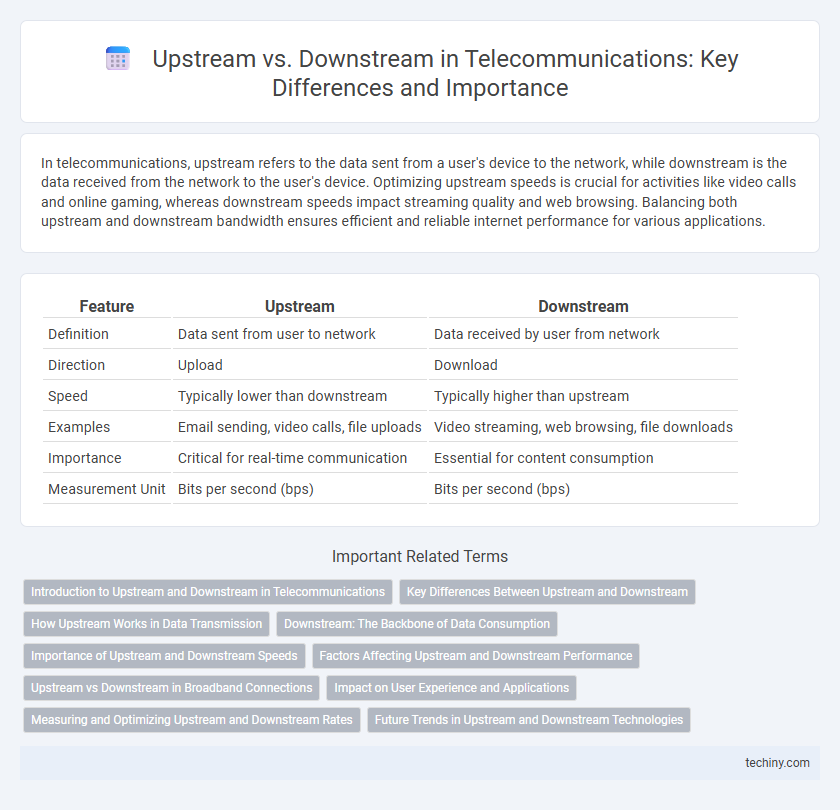In telecommunications, upstream refers to the data sent from a user's device to the network, while downstream is the data received from the network to the user's device. Optimizing upstream speeds is crucial for activities like video calls and online gaming, whereas downstream speeds impact streaming quality and web browsing. Balancing both upstream and downstream bandwidth ensures efficient and reliable internet performance for various applications.
Table of Comparison
| Feature | Upstream | Downstream |
|---|---|---|
| Definition | Data sent from user to network | Data received by user from network |
| Direction | Upload | Download |
| Speed | Typically lower than downstream | Typically higher than upstream |
| Examples | Email sending, video calls, file uploads | Video streaming, web browsing, file downloads |
| Importance | Critical for real-time communication | Essential for content consumption |
| Measurement Unit | Bits per second (bps) | Bits per second (bps) |
Introduction to Upstream and Downstream in Telecommunications
Upstream and downstream in telecommunications refer to the flow of data between a user and the internet service provider, where downstream is the data received by the user, and upstream is the data sent from the user. Downstream bandwidth typically supports activities such as streaming and downloading, while upstream capacity is crucial for uploading files, video conferencing, and real-time communication. Understanding the distinction and balance between upstream and downstream speeds is essential for optimizing network performance and user experience.
Key Differences Between Upstream and Downstream
Upstream in telecommunications refers to data sent from a user's device to the network, while downstream denotes data received from the network to the device. The key differences include bandwidth allocation, with downstream typically having higher capacity to accommodate data-heavy activities like streaming, whereas upstream is optimized for sending requests and uploading data. Latency and speed also vary, impacting the efficiency of applications such as video conferencing (upstream) versus content consumption (downstream).
How Upstream Works in Data Transmission
Upstream in data transmission refers to the flow of data from a user's device to the internet or central server, crucial for activities like uploading files, video calls, and sending emails. It operates by transmitting data packets through an upstream channel within the network infrastructure, often utilizing protocols such as Transmission Control Protocol (TCP) or User Datagram Protocol (UDP) to ensure efficient and reliable delivery. Network devices like modems and routers manage upstream bandwidth allocation to optimize speed and minimize latency, directly impacting the quality of real-time communications and cloud applications.
Downstream: The Backbone of Data Consumption
Downstream represents the flow of data from the internet to the end user's device, enabling activities such as video streaming, file downloads, and web browsing. It constitutes the primary bandwidth used by consumers, often requiring higher capacity to support high-definition content and rapid content delivery. Efficient downstream infrastructure is critical for maintaining service quality and meeting the escalating demand for data consumption in modern telecommunications networks.
Importance of Upstream and Downstream Speeds
Upstream speed is crucial for activities like video conferencing, online gaming, and uploading large files, ensuring smooth real-time communication and efficient data transfer. Downstream speed impacts the quality of streaming, downloading, and browsing, enabling faster content consumption and better user experience. Balancing both upstream and downstream speeds optimizes overall network performance, supporting interactive applications and high-bandwidth services in modern telecommunications.
Factors Affecting Upstream and Downstream Performance
Upstream and downstream performance in telecommunications is influenced by factors such as signal attenuation, noise interference, and bandwidth allocation. Upstream speeds are often limited by network congestion and the quality of the user's upload channel, while downstream performance depends heavily on the download channel's capacity and the efficiency of data transmission protocols. Environmental conditions, hardware capabilities, and service provider infrastructure also play critical roles in determining overall connection quality.
Upstream vs Downstream in Broadband Connections
Upstream in broadband connections refers to the data sent from the user's device to the internet, such as uploading files or sending emails, while downstream pertains to the data received from the internet to the user, like streaming videos or downloading files. Broadband technologies like DSL, cable, and fiber optic connections often offer higher downstream speeds compared to upstream speeds to accommodate typical user behavior and ISP network designs. Understanding the balance between upstream and downstream speeds is crucial for optimizing internet performance, especially for activities requiring substantial data upload bandwidth like video conferencing and online gaming.
Impact on User Experience and Applications
Upstream and downstream speeds critically impact user experience and application performance in telecommunications, with downstream bandwidth primarily affecting content consumption like video streaming and browsing, while upstream capacity governs activities such as video conferencing and cloud backups. High downstream speeds reduce buffering and improve load times, enhancing multimedia enjoyment, whereas robust upstream speeds ensure smoother real-time interactions and faster data uploads for collaborative applications. Balancing upstream and downstream throughput is essential for comprehensive service quality, especially as interactive services and Internet of Things (IoT) devices demand symmetrical or near-symmetrical bandwidth.
Measuring and Optimizing Upstream and Downstream Rates
Measuring upstream and downstream rates involves using network diagnostic tools such as speed tests and traffic analyzers to identify data transfer speeds and latency in telecommunications systems. Optimizing these rates requires adjusting bandwidth allocation, enhancing signal quality, and implementing Quality of Service (QoS) protocols to prioritize critical data flows. Accurate measurement and continuous optimization improve overall network performance, reduce bottlenecks, and enhance user experience in high-demand applications.
Future Trends in Upstream and Downstream Technologies
Future trends in upstream and downstream telecommunications technologies focus on enhancing data speeds and reducing latency through advancements like 5G and fiber-optic networks. Emerging technologies such as edge computing and AI-driven network management optimize bandwidth allocation and improve the efficiency of data transmission in both directions. These developments support expanding IoT ecosystems, real-time cloud applications, and ultra-high-definition video streaming.
Upstream vs Downstream Infographic

 techiny.com
techiny.com